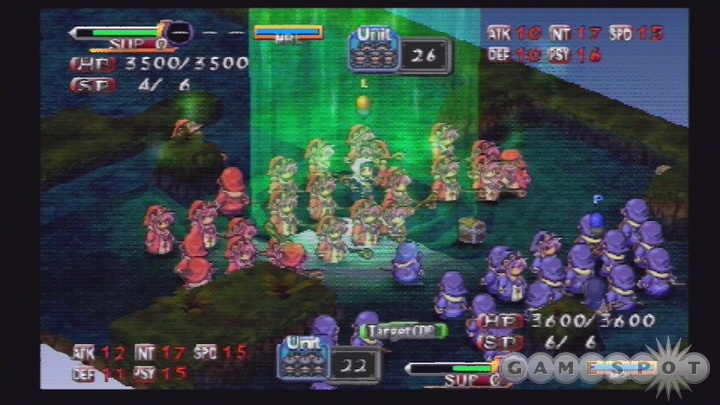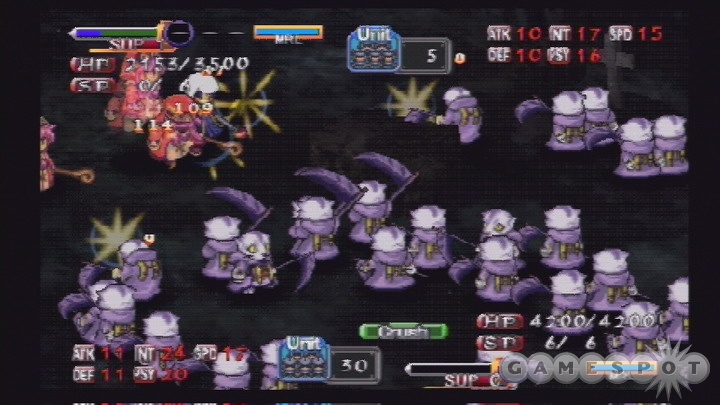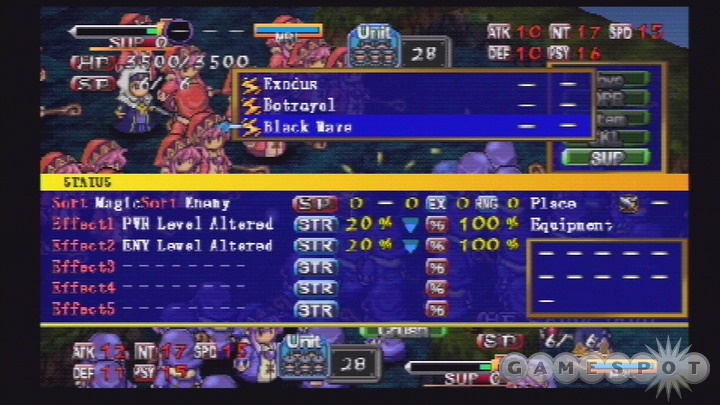Despite the fact that it has a distinctly anime-influenced style and is published by Nippon Ichi, Generation of Chaos doesn't fit the standard strategy role-playing mold. In fact, the latest game from developer Idea Factory is more akin to a pure turn-based strategy game like Romance of the Three Kingdoms than it is to the more RPG-flavored Final Fantasy Tactics or Disgaea. That's a good thing, though, because Generation of Chaos is unique and interesting enough to be compelling. That it manages to be enjoyable despite some serious technical problems and a prohibitively steep learning curve is a testament to how good this game could have been. As it is, it's a game that will appeal to only the most devout strategy fans, because everyone else will give up on it long before the pay off.
Generation of Chaos takes place in the world of Lost Grounds, which is basically a large battlefield where 10 different kingdoms are perpetually locked in a violent power struggle. When you start the game you can only choose between two different kingdoms, and by completing one of those campaigns you'll unlock the other eight kingdoms. Each campaign consists of several chapters, with in-game cutscenes in-between that help move the story along. Unfortunately the story just isn't presented well enough to make you actually care about what's going on. There just isn't any context to support the lengthy text and cryptic dialogue you'll see between chapters. That's alright though, because the story is just filler anyway, and the draw lies in the mixed strategy of the gameplay.
When you begin a chapter you're briefly introduced to one or more enemies that you have to defeat in order to move on. Everything takes place on a large, segmented map that is filled with interconnected towns, forts, castles, caves, and other structures. Each bit of the map that you move through or occupy belongs to you, and for each town you control you'll earn money each turn. The idea is to expand your kingdom by strategically securing as much of the map as possible, while fortifying and protecting your kingdom against enemy attack. You can invade enemy towns and take them as your own, invest in your markets, develop land and build new structures, recruit or execute enemy commanders, search new areas for treasure, and much more. Of course, you're limited by the amount of funds you have, and by the fact that you can only perform five actions per turn. As your empire expands this intricate balancing act provides the bulk of the challenge to be found in the game. If any of your main commanders are defeated, it's game over and you have to reload your last save. Fortunately you can save at any point during battle.
Whenever you move to an occupied square on the map you'll initiate combat. The battles play out in real-time between commanding officers, and each commanding officer can have up to 29 subordinate units under his or her control. Before each battle you can assign a formation and designate a general order such as kill everything, focus on the enemy commander, or defend. Most battles end when one of the commanding officers is killed, but some battles are slightly more involved and require you to destroy enemy fortifications.
At any time during combat you can press the X button to issue new commands. You can move your units or commander, issue new battle orders, or perform special skills and super attacks. Skills include magic spells and special physical attacks that target large groups of enemies. Since these skills require skill points to perform, your use of them is limited. The most powerful and eye-catching moves you can perform are the super moves. Each commanding officer has a few special moves that can be performed when his or her super gauge is full. The super gauge is filled when you attack, lose units, or take damage, and you can store up to three supers, which can be unleashed at will. Some of these super moves simply do massive damage to all of your enemies, and others inflict various status effects on your enemies or allies. Some commanders have unique super moves that are accompanied by flashy animated cutscenes and dramatically shouted dialogue. These effects look great, but they're overdrawn and tend to slow the flow of battle. There is an option to turn the effects off, which you'll probably want to utilize after you've seen each move a couple times.
Aside from the special moves, super moves, orders, and formations, there are a few other factors that affect the outcome of battle. For instance, some units get bonuses or penalties depending on the time of day or the type of terrain you're fighting in. Vampires turn into bats during the daytime, werewolves gain strength in fog, and so on. You also have to consider the types of units you're fighting. As you might expect, ranged units like archers and mages are poorly suited to melee combat, but can inflict heavy damage from a distance. Units also have improved defense against other units of the same type. As a result you aren't quite guaranteed to win a battle just because you have more units or a stronger commanding officer.

If you do win a battle you can often take the enemy officer as a prisoner. You can choose to release or execute each officer, or you can attempt to convert the officer to fight for you. There are dozens of unique officers in the game, and it can be fun to try to grow your army by assimilating enemy commanders. You can command up to 50 officers at a time, but the number of officers that you can feasibly juggle effectively is much fewer than that. As you fight your officers will level up, and you can allocate bonus points to stats like power, defense, luck, and intelligence. You can only level up each officer a few times though, so for the most part you can't simply create one or two overly powerful officers to do the work of your entire army.
Between empire building, resource management, and political strategy, there's a lot to bear in mind while planning your strategy. That complexity makes the game nearly impenetrable at first, because there's no tutorial and the manual doesn't explain much. It doesn't help that you often have to dig through menus and sub menus full of abbreviated and confusing commands just to perform a simple action. If you've played turn-based strategy games you'll have an advantage when it comes to learning how to play, but you'll still probably want to an external source of help such as a friendly message board or game guide to get an idea of what you're supposed to do. After a couple hours you'll start to get an idea of how to play, but that's much longer than most people's patience will allow.
In addition to the learning curve your patience will also be tested by the fact that the game moves extremely slowly. It can easily take two or more hours to clear a chapter, and the protracted strategy becomes even more so when you're battling several enemies at once. In combat everything moves in slow motion, which is helpful because it gives you plenty of time to react, but the syrupy pace quickly becomes tiresome. There are also frequent, though brief, loading times that drag the game down. At times even a voiced portion of the dialogue will be interrupted midsentence as it loads, which just sounds bad.

Aside from the load times, slow-motion battles, and unfriendly interface, Generation of Chaos is presented fairly well. The character sprites are all detailed and the static character portraits look great. As mentioned, the battle effects are great, but you'll eventually probably want to turn them off in the interest of saving time. The audio takes a hit as it's delayed while loading, but it still sounds fair. The music is well done and it accompanies the drama of warfare nicely. The voices are cheesy, and sometimes broken, but occasionally they do end up providing apt character for the associated officers. You can also choose to listen to the Japanese voices if you are so inclined.
Generation of Chaos demands a lot of effort and patience to really enjoy, which is a flaw that's compounded by the fact that it is a portable game. For most people it will take more than a single charge of the PSP for this game to actually start delivering a remotely fun or even coherent experience. As a result your enjoyment of the game will depend on how much time you're willing to spend getting into it, and on how much you enjoy strategy games in general. If you manage to stick with it, you'll find a lot to enjoy about Generation of Chaos, despite its technical flaws and go-nowhere pace.
